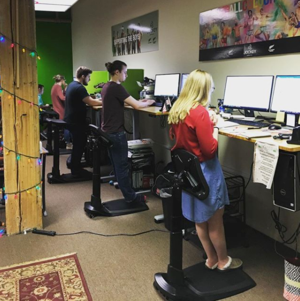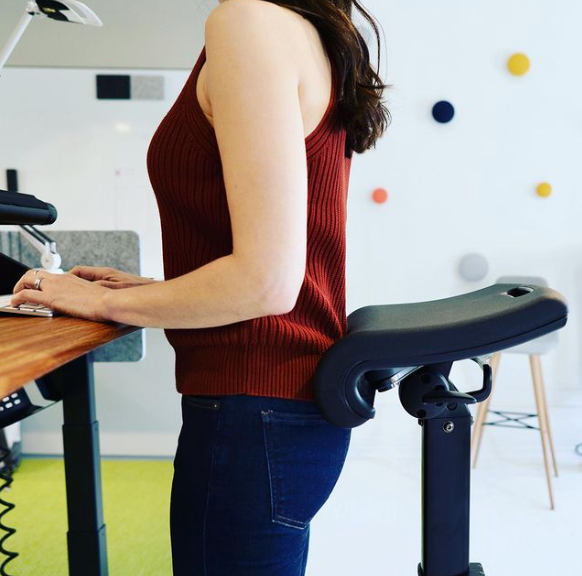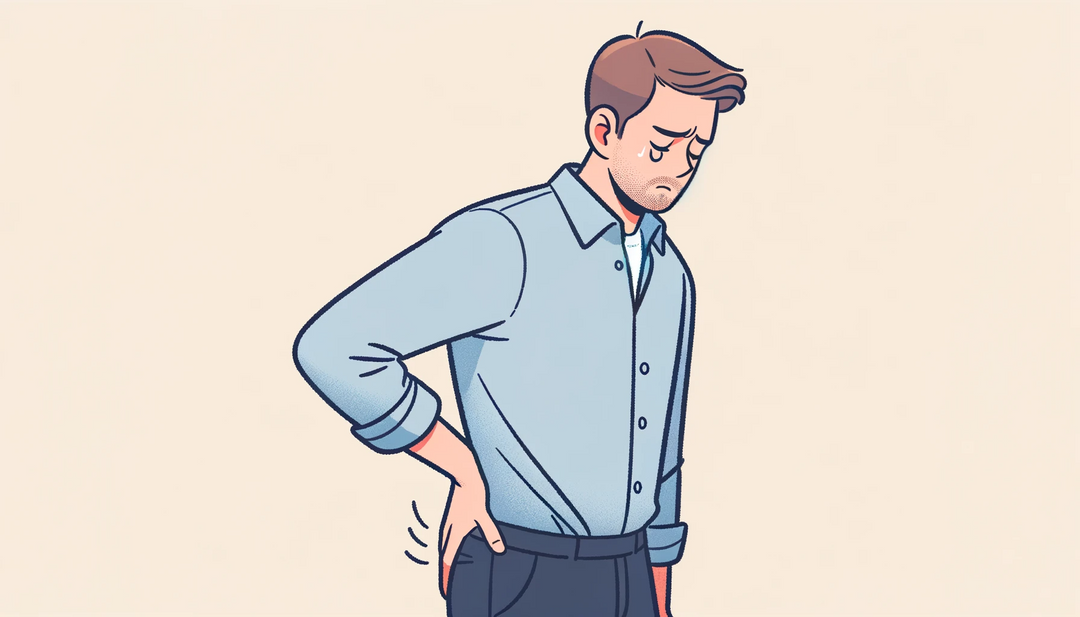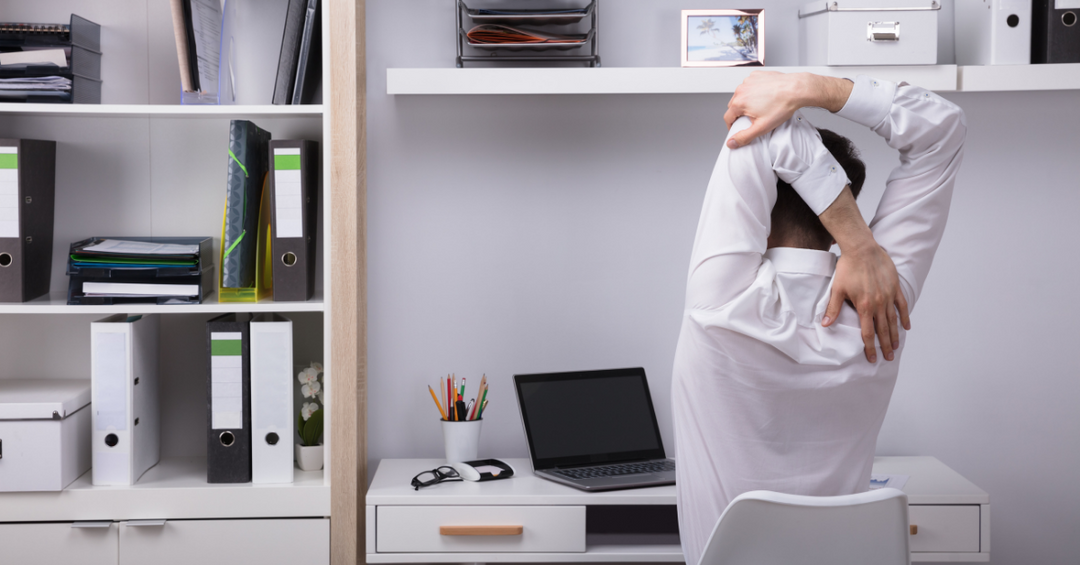Is Perching the New Sitting? Research Suggests Yes.


We’ve decided to dedicate a full blog post to the topic of perching after reviewing a groundbreaking new study out of the University of Waterloo’s Kinesiology department about how perching may be the ideal posture for those with low back pain.
While perching is a relatively nascent posture for deskbound workers, the science of its benefits has already inspired all kinds of innovative chairs that support the posture. Chairs like our LeanRite Elite which are designed to support you comfortably as you move through unconventional, yet comfortable postures such as the perch.
What is perching?
Perching is any posture that looks like it sounds: like a bit of a perch. In a perched posture, the pelvis is tilted slightly forward opening the hips and chest and facilitating a more neutral posture overall. Because perching is not quite a full sit yet not quite a full stand, researchers consider it the happy medium between sitting and standing (considering the costs and benefits of each).
In clinical terms, “perching is defined by a range of trunk-thigh angles, where the lumbopelvic angle is significantly different from sitting or standing."
What are the supposed benefits of perching?
Perching done correctly puts the spine in neutral posture — reducing unsupported extraneous loading in weaker spots along the spinal column — and may reduce low back pain. It opens the hips, and engages the core (which is a critical protection against and relief from lower back pain). This engagement of the core muscles can restore strength that was lost sitting for long periods in a typical office chair.
Where’s the science behind perching?
The groundbreaking study from uWaterloo illustrates how perching is a more ideal posture than sitting or standing for those who have low back pain (LBP) because it facilitates a ‘neutral spine’ posture, subjecting the back to less tension and stress.
“Posture is considered one of the risk factors for lower back pain and perching above certain degrees … can improve that..”-Mamiko Noguchi, Graduate Student, PhD, Kinesiology, Biomechanics Researcher
In the study, the research team worked with a custom jig — similar to the LeanRite Elite’s adjustable seat. They adjusted the jig and studied each posture supported by each jig angle to identify the seat angle that puts the lightest load on the spine.
Because the hybrid posture of the perch was easier on the back than both sitting and standing, the team recommended a ‘hybrid’ kind of chair to those with low back pain. One that supports the body in hybrid perch-like postures from sit to stand. Below, see how the LeanRite delivers this dynamic hybrid chair quality — with a seat post that is adjustable in height, affording a wide range of movement and support.
Learn more about our Leanrite Elite standing desk chair: www.ergoimpact.com/blog/what-is-a-standing-desk-chair
The bigger idea: a desk setup as dynamic as you are
In an older study (2016) published in Applied Ergonomics, researchers took a close look at how the three popular working postures affected the low back — sitting, standing, and, our friend in close review: the perch. They found that standing with no support puts the most stress on the back, while perching puts the least. Each posture has trade-offs, though, between spinal load (low back pain), discomfort, and productivity.
The takeaway: your desk setup should be dynamic by design — supporting you continuously through every position, from sit to perch to stand. What does a dynamic desk setup look like exactly? Think of the following kinds of equipment: a footstool, mat, height-adjustable desk, and super-adjustable chair that support you as you move through a variety of postures.
Learn more about our Leanrite Elite standing desk chair: www.ergoimpact.com/blog/what-is-a-standing-desk-chair
Try it out for yourself…
Your body’s mechanics are a personal thing. You can create a makeshift ‘perch’ by rolling up a towel and placing it on the edge of whatever chair you’re currently sitting on. Sit with your hip bones square on the towel wedge and voilà!, you are experiencing a seated ‘perch.’
With your pelvis tilted slightly forward, you hips are opened, and your spine is supported in a more neutral, natural posture. So... how does it feel? How does your lower back feel? Your hip flexors? Is it easier to stretch your legs out with your pelvis tilted forward like this? Does the posture seem to engage your core or open your chest up at all?
Though this is pseudo-version of the perch posture reviewed in the studies mentioned (because you are still fully seated) you can probably sense a better alignment in your spine. If it works for you, add the posture to your arsenal of ways to sit!
Perching: a gateway into more movement
The real beauty of any posture that is a mixture of sitting and standing is that such a hybrid posture is a natural gateway into more movement. On the other hand, sitting encourages more sitting because it is too comfortable and static. And standing (without the support of a good chair) fatigues the body, forcing one to return to the chair. Both sitting and standing are sedentary postures that create that pain, fatigue, and stiffness in the first place.
A hybrid posture such as the perch is a different ball game entirely. When your muscles are engaged, awareness is brought back into your body, and you are tuned into how you feel and when it is time to move to the next position. Which is the goal, ultimately… to change positions as natural and comfortable, keeping your body in motion!
This is an enormous benefit because movement is one of the basic ingredients needed to heal the pains associated with desk work. Movement is linked with less swelling in the lower body, more motion in the spine, and periodic rest of the musculature, which reduces spinal load and overall fatigue.
This all sounds great, but I don’t want an extra load on my legs and feet…
The potential drawbacks of a leaning or standing perch are clear — standing partly upright puts stress on the legs and feet, right? Well yes, and no. A standing mat coupled with the right standing height stool (like the LeanRite) that provides lumbar support brings the concept of the perch home by fully supporting all variations of comfortable semi-standing postures. What exactly does that mean? The idea is not to perch all day, but to move through postures, comfortably, easily, and naturally — because this movement is the key to keeping the body feeling good.
If you haven’t had the opportunity to use an anti-fatigue mat before, all you need to know is that a quality one takes the stress off your lower body in 2 ways :
Distributes the weight of your body more evenly
Gives comfortable cushion to the feet
Additionally, a good mat actively engages the muscles in the legs as they counteract the cushion of the mat to maintain stability, giving you more energy, and preventing fatigue.
The mat coupled with a great chair that supports you as you move will ensure you don’t feel that extra load on your legs and feet, AND that you are able to rest in a more traditional sitting position when your legs tire.
Because whether you sit, stand, perch, or lean… movement wins
A chair that allows you to move through positions is ideal — from sit, to stand, to perch, to lean, and every comfortable posture in between. Through movement we can tune into how our body feels and make the right adjustments to our desk setup and daily routine. Conversely, through static sitting or standing we can lose touch with key indicators that our body isn’t happy (tight hips, tingly legs, sore back…).
Do you want to be more active at the desk? What challenges do you run into? Any hacks that have helped you reach your aim?




















Leave a comment